tire size CHEVROLET S10 1996 2.G Owners Manual
[x] Cancel search | Manufacturer: CHEVROLET, Model Year: 1996, Model line: S10, Model: CHEVROLET S10 1996 2.GPages: 375, PDF Size: 20.73 MB
Page 173 of 375
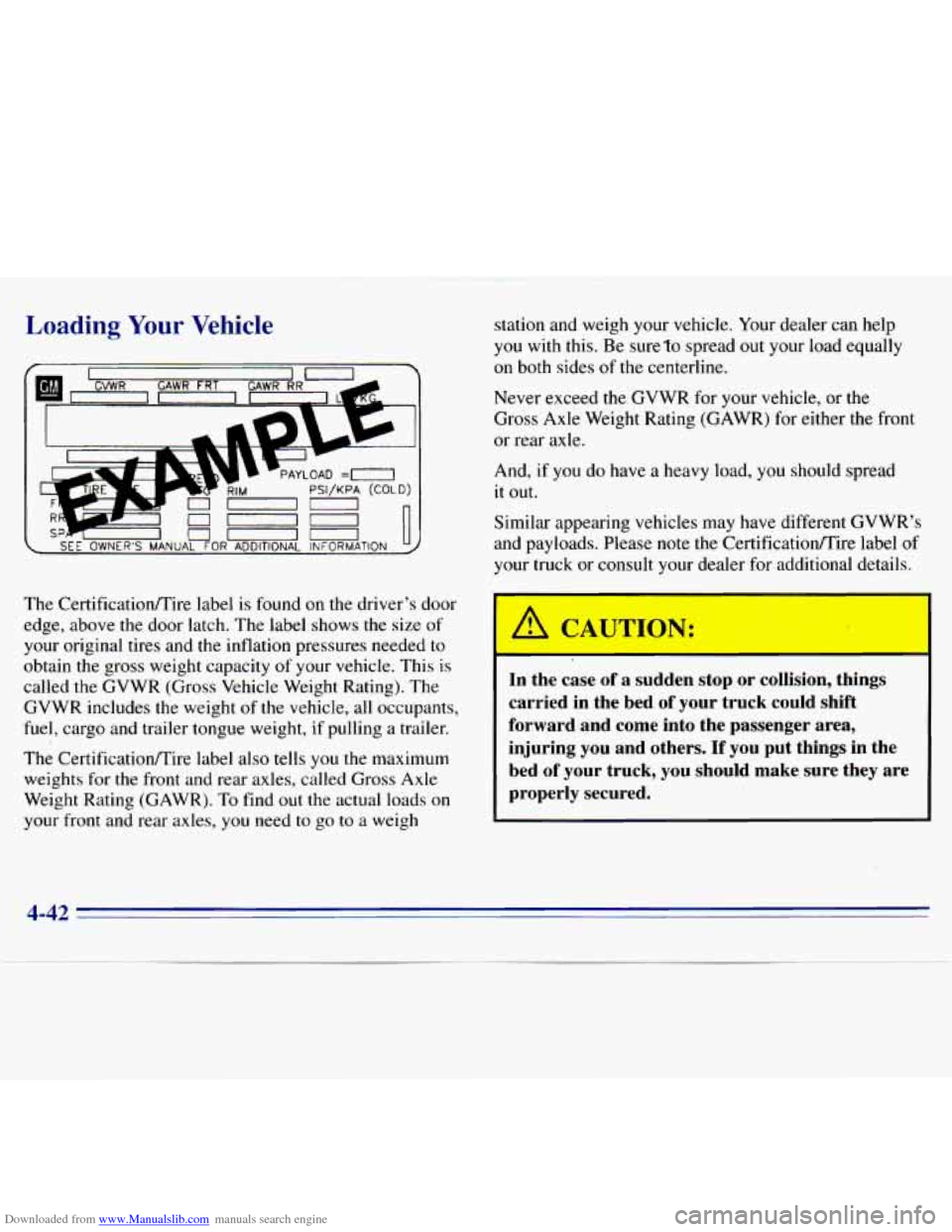
Downloaded from www.Manualslib.com manuals search engine Loading Your Vehicle
< SEE OWNER'S MANUAL FOR ADDITIONAL INFORMATION uu-
The CertificatiodTire label is found on the driver's door
edge, above
the door latch. The label shows the size of
your original tires and the inflation pressures needed to
obtain the gross weight capacity of your vehicle. This is
called the GVWR (Gross Vehicle Weight Rating). The
GVWR includes the weight
of the vehicle, all occupants,
fuel, cargo and trailer tongue weight, if pulling a trailer.
The Certificationmire label also
tells you the maximum
weights for the front and rear axles, called Gross Axle
Weight Rating (GAWR). To find out the actual loads
on
your front and rear axles, you need to go to a weigh station and weigh your vehicle.
Your dealer can help
you with this. Be sure'to spread out your load equally
on both sides of the centerline.
Never exceed the GVWR for your vehicle, or
the
Gross Axle Weight Rating (GAWR) for either the front
or rear axle.
And, if you do have a heavy load, you should spread
it out.
Similar appearing vehicles may have different GVWR's
and payloads. Please note the Certificationire label
of
your truck or consult your dealer for additional details.
I
. A CAUTION:
I
In the case of a sudden stop or collision, things
carried in the bed of your truck could shift
forward and come into the passenger area,
injuring you and others.
If you put things in the
bed of your truck, you should make, sure they are
properly secured.
4-42
Page 182 of 375
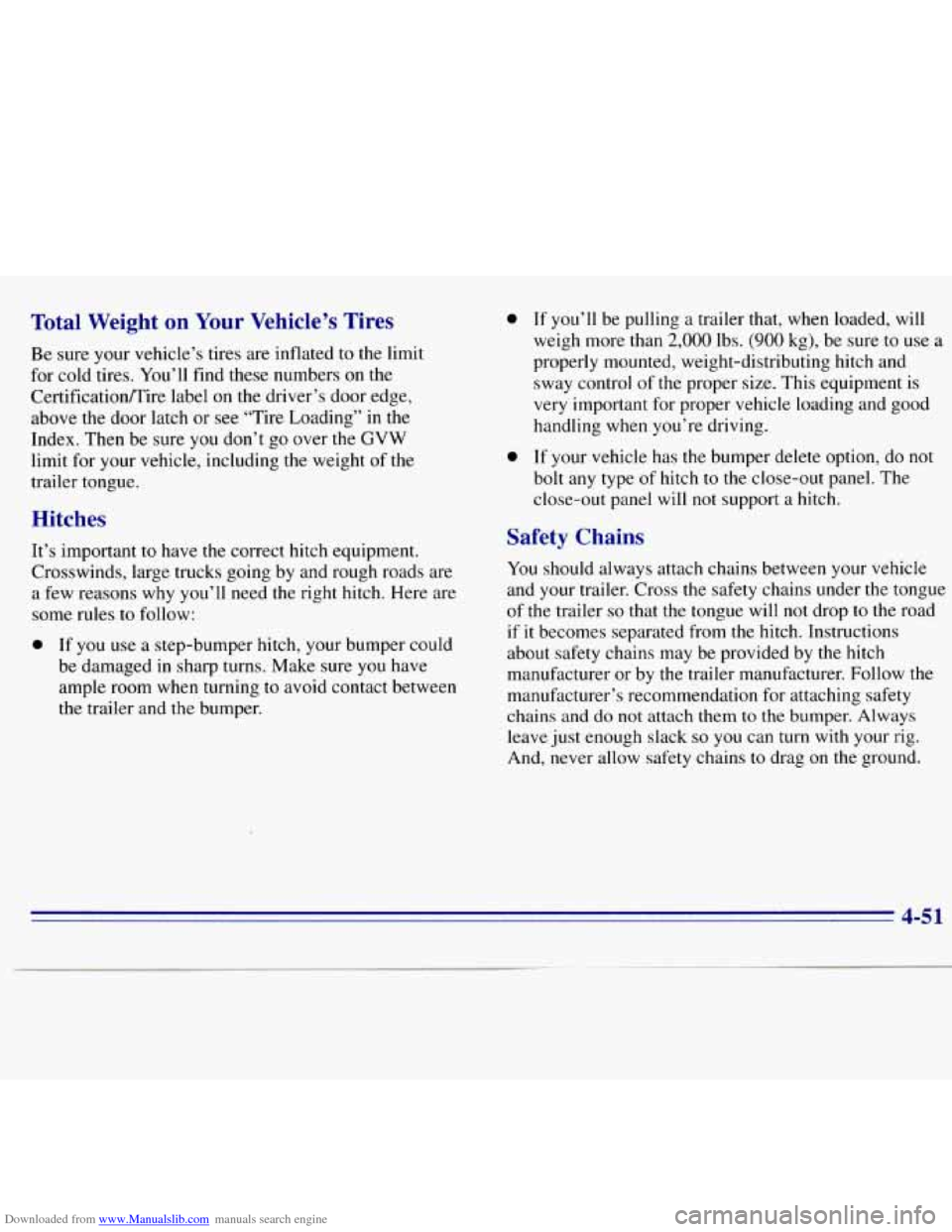
Downloaded from www.Manualslib.com manuals search engine Total Weight on Your Vehicle’s Tires
Be sure your vehicle’s tires are inflated to the limit
for cold tires. You’ll find these numbers
on the
CertificatiodTire label on the driver’s door edge,
above the door latch or see “Tire Loading” in
the
Index. Then be sure you don’t go over the GVW
limit for your vehicle, including the weight of the
trailer tongue.
Hitches
It’s important to have the correct hitch equipment.
Crosswinds, large trucks going by and rough roads are
a few reasons why you’ll need the right hitch. Here are
some rules
to follow:
0 If you use a step-bumper hitch, your bumper could
be damaged
in sharp turns. Make sure you have
ample room when turning to avoid contact between
the trailer and the bumper.
0
0
If you’ll be pulling a trailer that, when loaded, will
weigh more than
2,000 lbs. (900 kg), be sure to use a
properly mounted, weight-distributing hitch and
sway control
of the proper size. This equipment is
very important for proper vehicle loading and good
handling when you’re driving.
If your vehicle has the bumper delete option, do not
bolt any type
of hitch to the close-out panel. The
close-out panel will not support a hitch.
Safety Chains
You should always attach chains between your vehicle
and your trailer. Cross the safety chains under the tongue
of the trailer
so that the tongue will not drop to the road
if it becomes separated from the hitch. Instructions
about safety chains may be provided by the hitch
manufacturer or by the trailer manufacturer. Follow the
manufacturer’s recommendation
for attaching safety
chains and do
not attach them to the bumper. Always
leave just enough slack
so you can turn with your rig.
And, never allow safety chains to drag on the ground.
4-51
Page 222 of 375
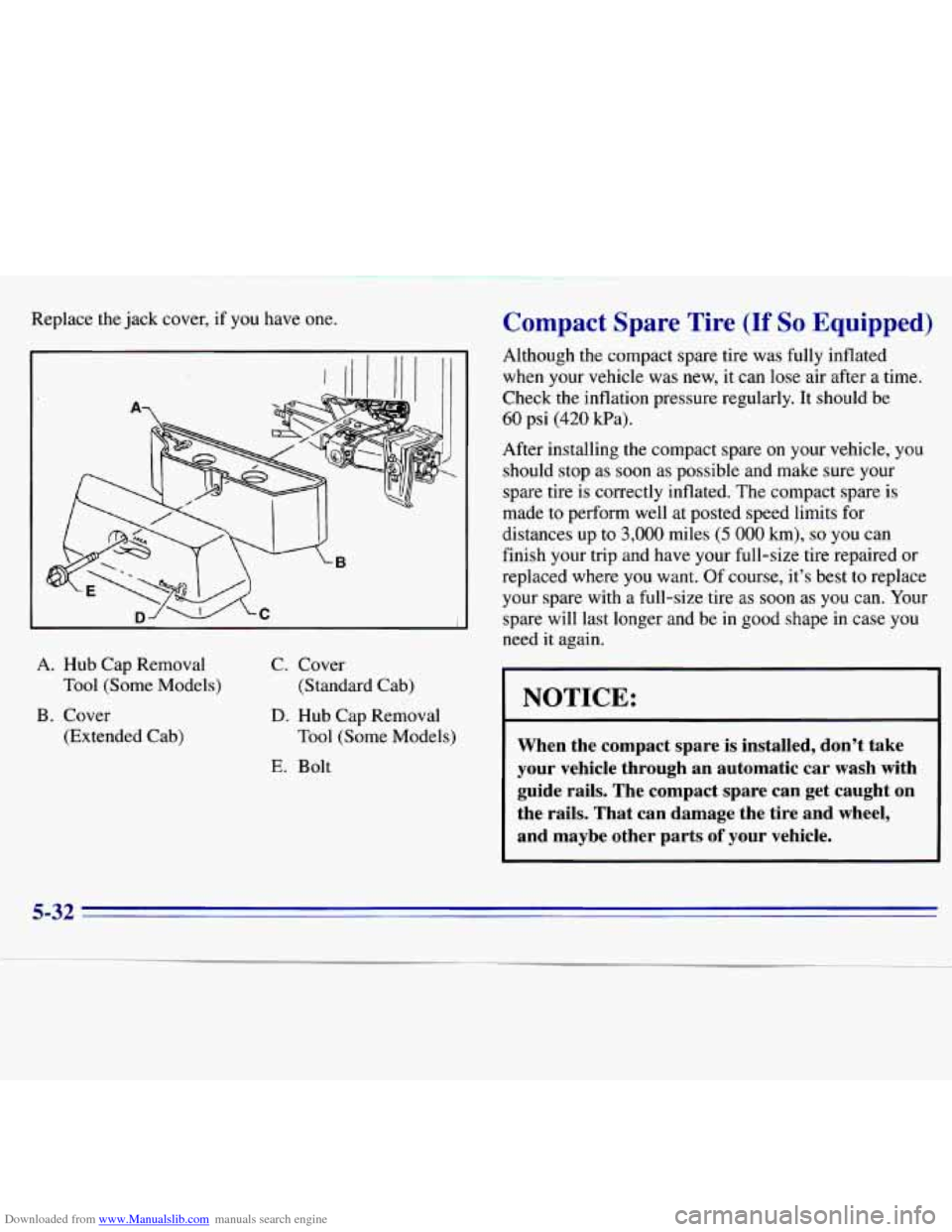
Downloaded from www.Manualslib.com manuals search engine Replace the jack cover, if you have one.
A. Hub Cap Removal
Tool (Some Models)
B. Cover
(Extended Cab) C.
Cover
(Standard Cab) D. Hub Cap Removal
E. Bolt Tool
(Some Models)
Compact Spare Tire (If So Equipped)
Although the compact spare tire was fully inflated
when your vehicle was new,
it can lose air after a time.
Check the inflation pressure regularly. It should be
60 psi (420 Pa).
After installing the compact spare on your vehicle, you
should stop as soon as possible and make sure your
spare tire is correctly inflated. The compact spare is
made to perform well at posted speed limits for
distances up to
3,000 miles (5 000 km), so you can
finish your trip and have your full-size tire repaired or
replaced where you want.
Of course, it’s best to replace
your spare with
a full-size tire as soon as you can. Your
spare will last longer and be
in good shape in case you
need it again.
NOTICE:
When the compact spare is installed, don’t take
your vehicle through an automatic car wash
with
guide rails. The compact spare can get caught on
the rails. That can damage the tire and wheel,
and maybe other parts
of your vehicle.
5-32
Page 274 of 375
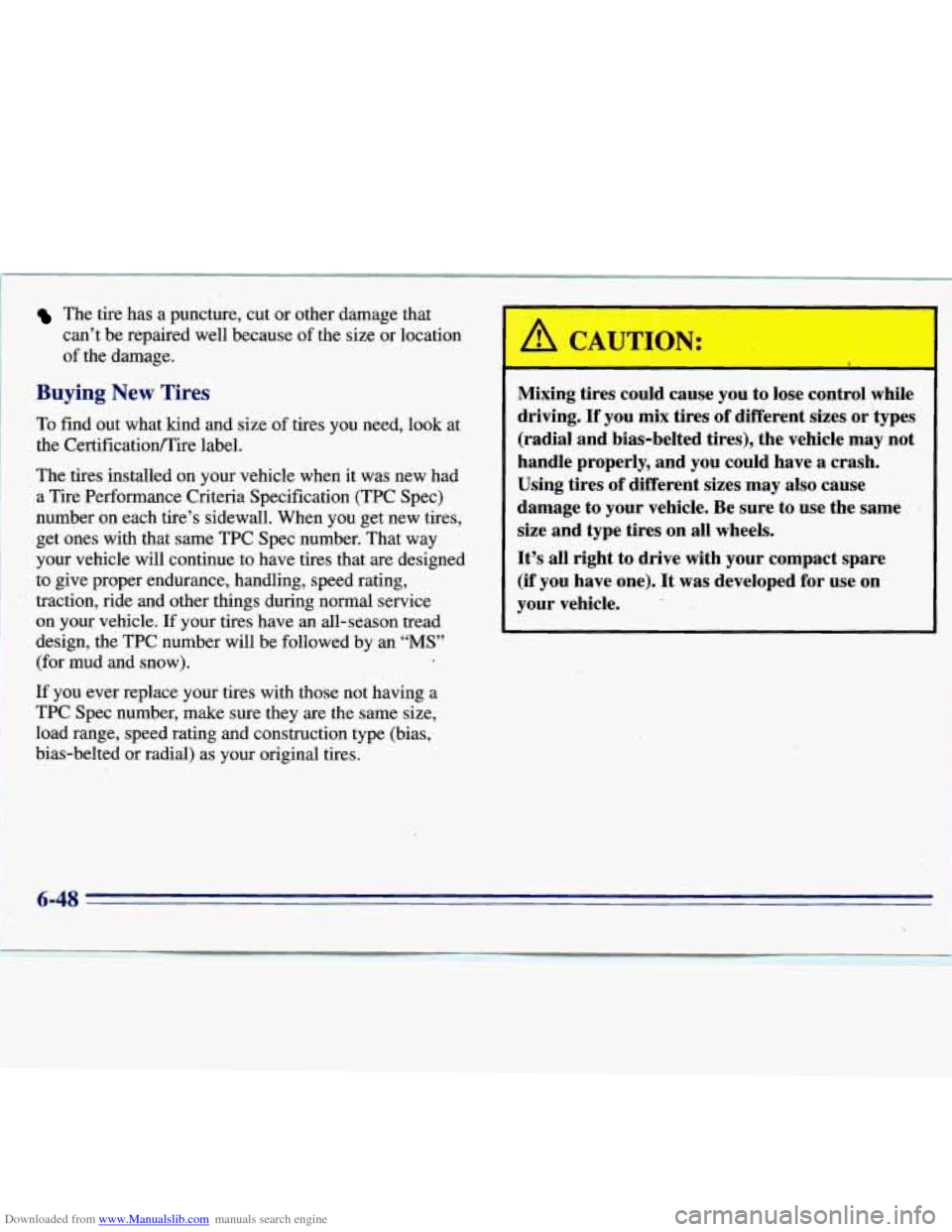
Downloaded from www.Manualslib.com manuals search engine The tire has a panctufe, cut or other .damage that
can’t be repaired well because of the size or location
. of the damage.
Buying New Tires
To find out what kind and size of tires you need, look at
the Certificatioflire label.
The tires installed on your vehicle when it was new had
a Tire Performance Criteria Specification (TPC Spec)
number on each tire’s sidewall. When you get new tires,
get ones with that same TPC Spec number. That way
your vehicle will continue to have tires that are designed
to give proper endurance, handling, speed rating,
traction, ride and other things during normal service
on your vehicle.
If your tires have an all-season tread
design, the TPC number will be followed by an
“MS”
(for mud and snow).
If you ever replace your tires with those not having a
TPC Spec number, make sure they are the same size,
load range, speed rating and construction type (bias,
bias-belted or radial)
as your original tires. Mixing
tires could cause you to lose control while
driving.
If you mix tires of different sizes or ‘types
(radial and bias-belted tires), the vehicle may not
handle properly, and you could have
a crash.
Using tires of different sizes may also cause
damage to your vehicle. Be sure to use the same
size and type tires on all wheels.
It’s all ,right to drive with your compact spare
(if you have one).. It was developed for use on
your vehicle.
Page 278 of 375
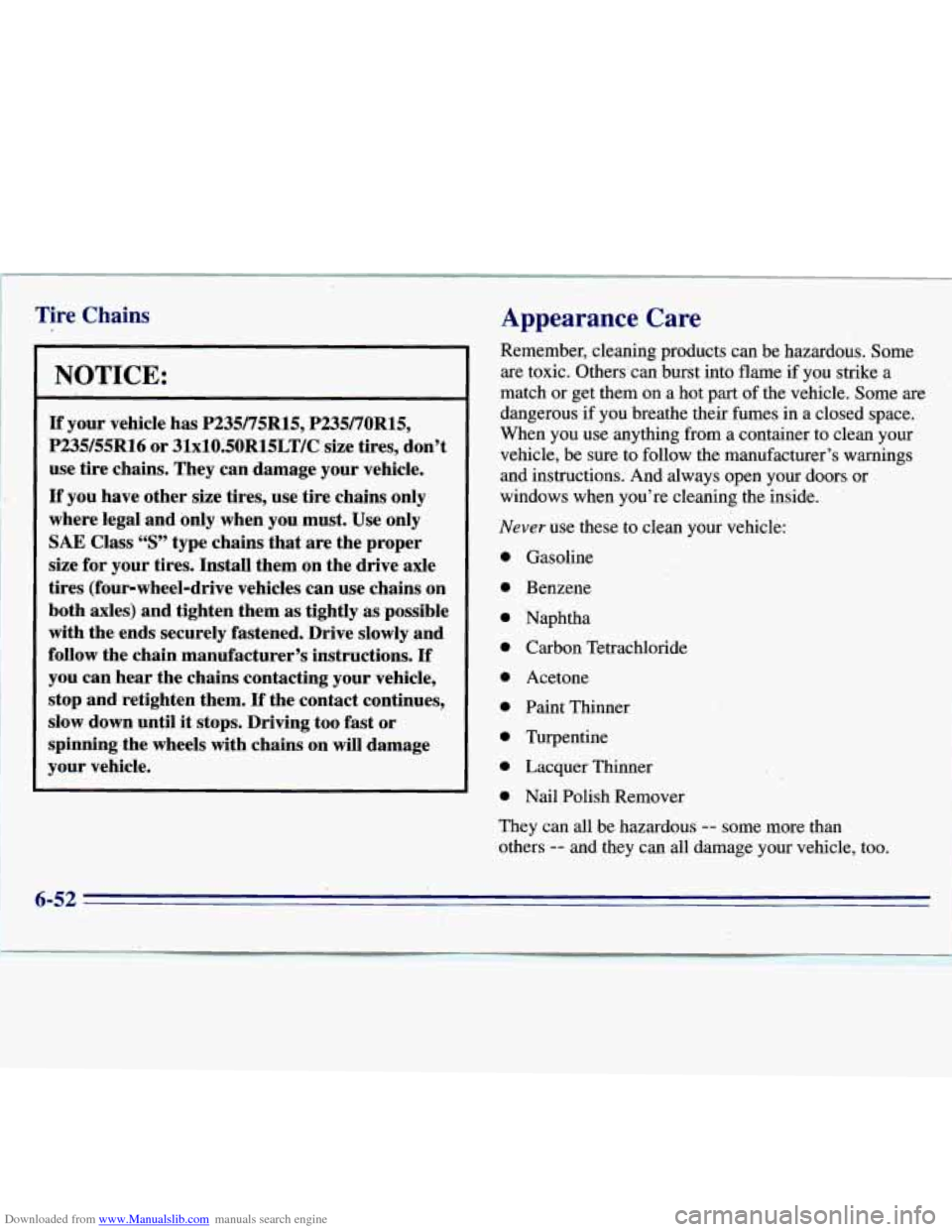
Downloaded from www.Manualslib.com manuals search engine Tire Chains
NOTICE:
If your vehicle has P235/75R15, P23970R15,
P235/55R16 or 3lxlO.5OR15LT/C size tires, don’t
use tire chains. They can damage your vehicle.
If you have other size tires, use tire chains only
where legal and only when you must. Use only
SAE Class “S” type chains that are the proper
size for your tires. Install them on the drive axle
tires (four-wheel-drive vehicles can use chains on
both axles) and tighten them as tightly as possible
with the ends securely fastened. Drive slowly and
follow the chain manufacturer’s instructions.
If
you can hear the chains contacting your vehicle,
stop and retighten them.
If the contact continues,
slow down until it stops. Driving too fast or
spinning the wheels with chains on will damage
your vehicle.
Appearance Care
Remember, cleaning products can be hazardous. Some
are toxic. Others can burst into flame if you strike a
match or get them
on a hot part of the vehicle. Some are
dangerous if you breathe their fumes in a closed space.
When
you use anything from a container to clean your
vehicle, be sure to follow the manufacturer’s warnings
and instructions. And always open your doors or
windows when you’re cleaning the inside.
Never use these to clean your vehicle:
0 Gasoline
0 Benzene
0 Naphtha
0 Carbon Tetrachloride
0 Acetone
0 Paint Thinner
0 Turpentine
0 Lacquer Thinner
0 Nail Polish Remover
They can all be hazardous
-- some more than
others
-- and they can all damage your vehicle, too.
I
‘ 6-52